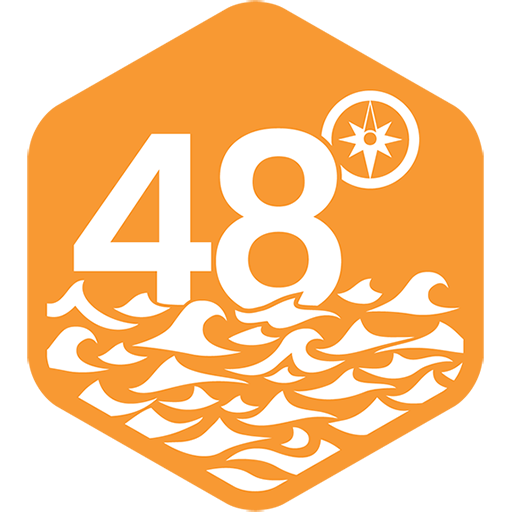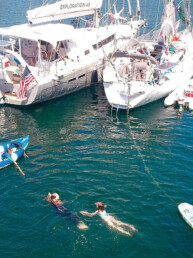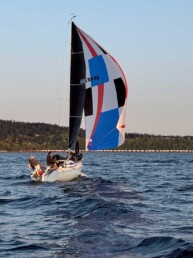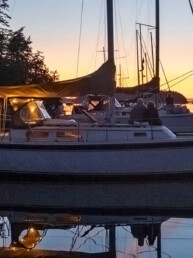Reminiscing on the highlights of cruising in the wondrous Salish Sea
Our boating has been filled with memorable moments. There was that first, and thankfully only, moment I forgot to shorten the dinghy towline before setting the anchor—then spent the rest of the day disengaging the line from the prop.
There was the time the engine stopped in the Duwamish Waterway as we were leaving the marina, because I had forgotten to turn the fuel valve back on after changing the Racor filter. And the moment we entered a major rapids when it was still moving quickly, because I hadn’t correctly read the current table.
“It could happen to anyone,” I said to myself.
And of course, there were the multiple times we realized the waves in front of us were much bigger than they appeared from a distance.
These moments are remembered for the sheer terror they engendered at the time. But along with those times when cruising was stressful or unenjoyable, there are many more instances of magical discovery and wonder that only a cruiser can encounter. And there’s no better place to experience these awe-inspiring moments than in the waters of the Pacific Northwest. Here are a few of my favorites.
THE GLOW
Early in our boating career, long before we actually owned a boat, we went on our first sailboat charter. We were beginners. It was pretty daring, actually, flying to Desolation Sound in a charter float plane and trading places with the boat’s owner in Tenedos Bay to spend the next three weeks cruising the area and bringing the boat back to Seattle.
One night we were anchored all alone in tiny Isabel Bay when I got up in the dark for a trip to the head. As I pumped, I was totally mesmerized by the flow of bright, blue-green phosphorescent water. I woke Karen and we both pumped and watched until the holding tank would hold no more. It was, for us, a truly magical moment, something we had never seen before—and could only have seen from a boat. So this was what cruising was about. We were hooked.
Another time, we were visiting a fellow cruising boat after dark and had to row back to our boat. The dinghy’s wake was afire, and each dip of the oars produced a circle of light with a trail of dots as the water dripped off the oars when they were raised. Dipping our hands in the water created its own pool of green fire. Even though we were in Mystery Bay off Marrowstone Island, with plenty of light along the shore, we had never seen phosphorescence so bright.
Through all the years, we have looked for the glowing water every time we go out. When we get up at night, we always check for any phosphorescence. Sometimes it is very faint and it takes a quick swirl with the boat hook to reveal it; other times it is so strong that natural movement in the water will trigger the glow. We have seen the water sparkle from the flashes of small fish and watched the glowing trail of a seal swimming below the boat. These are magical moments.

MANY MOONS
While the days of bays filled so thickly with salmon you could practically walk across their backs are long gone, there are still sea creatures that occasionally fill the waters of some of our bays—moon jellies. These small jellyfish, up to 6 inches in diameter and harmless to humans, are just one of the types that sometimes migrate to spawn in the bays we anchor in. We have seen them many times in locations up and down the coast. They seem to rise out of the deeper water as the sun sets—perhaps they don’t like the light—and fill the water column from the surface as far down as you can see.
While some may think it creepy to see so many jellyfish in one place, we find it amazing that these simple creatures with limited locomotion can come together in such large numbers, and that they come to the very places to which we also flock. The final bit of magic is they are so well behaved; by day, they largely vanish into the depths, and we have luckily never had one clog our raw water strainers.

THE CANYONS

The cruising grounds of the Pacific Northwest were largely formed by glaciers in the fairly recent geological past. They carved out great valleys that filled with water, leaving the inlets and passages through which we cruise today. We recognize them immediately—deep water, sometimes really deep, with steep sides. And like Puget Sound, mostly large, but not always. Occasionally they are narrow, with particularly steep sides and deep water, like slot canyons for boaters. These are very special.
Every time we go to Princess Louisa Inlet, we are awed by the snow-covered mountains and numerous waterfalls on the way to Malibu Rapids. But once through, a different world opens up. The inlet narrows and the side slopes steepen, showing more rock; many cliffs plunge dramatically into the deep water. The wind dies, the water calms to almost glassy smoothness, and the slopes seem to block most of the sunlight.
At the inlet’s head a huge rock bowl emerges, with many waterfalls feeding massive Chatterbox Falls, which drop almost directly into the salt water of the inlet. This 5-mile cruise to the head of the inlet is truly magical, and as much as we like being at the head, we are always astounded by the journey of discovery in getting there. It is so unusual that we can see why Captain Vancouver thought it was a river valley and not a saltwater inlet.

While many think Princess Louisa Inlet is the best of the best, it does have company. Several times we have passed through Nakwakto Rapids and headed up Belize Inlet to the small opening that marks the beginning of Alison Sound. The entrance is narrow, but after the first bend the passage widens and the walls grow higher and steeper. Small river valleys briefly interrupt the otherwise near vertical terrain. Native art in red ochre from long ago still remains on the walls. The passage continues through more bends until it opens up to the head. The water is calm, the air is still, and the silence is broken only by the sounds of birds and the engine. It’s made even more magical by the fact that we are likely to be completely alone.
Farther north, on the B.C. central coast just north of Bella Bella, is Roscoe Inlet. Once past its narrow entrance, the inlet is wider than Princess Louisa but far longer; it winds 20 miles through mainland mountains before reaching the head. The cliffs aren’t as intimate, but the feeling of isolation is much greater. Roscoe Inlet, like Alison Sound, gets some of its magic from the feeling that you have stepped back in time to an earlier age of exploration.
Not all canyon passages are narrow inlets. Again, north of Bella Bella, the main route for commercial traffic passes through Graham Reach, Fraser Reach, and Grenville Channel. These are mostly straight, deep passages about 1 mile wide—plenty of room to get out of the way of the odd ferry or cruise ship. The surrounding mountains are steep but wooded to the waterline. The magic here is the waterfalls. Everywhere you look there is water falling, white streaks through a green world. I tried counting them once but quickly gave up. There are just too many.

THE BAYS
We spend a great deal of time at anchor and are always on the lookout for an extra special place. When we first started cruising, any place we could set the anchor and swing without hitting something or someone was special. Over time we have come to discover that some places are more than that.
The head of Alison Sound opens into a large river delta. As you would expect, anchoring can be challenging since the water rapidly goes from too deep to too shallow. We like to anchor in 90 feet on a short scope here. But unlike the typical mainland inlets such as Toba Inlet or Knight Inlet, the normal upslope and downslope winds are completely killed by the winding sound, and the head is totally calm. A little fog in the morning adds to the magic of this place.
Unusually, Roscoe Inlet ends in a small cove under high mountains but has reasonable anchoring depths. The inevitable river delta comes into the inlet a short distance away, making for great bear viewing from the boat or dinghy exploring. As with Alison Sound, inlet winds are dampened and the head is totally calm. Morning fog is also common here, but the day we were there the rising sun quickly burned it off, exposing pristine mountain views for the return journey out the inlet. It was another enchanting night at anchor.

One anchorage a bit closer to home has been magical for us for a completely different reason. Wahkana Bay is in the northeast corner of Gilford Island in the Broughtons. A short, deep entrance channel leads into a small and almost round bay. On the chart it doesn’t look promising; its bottom is almost flat, somewhat rocky and 115 feet deep. And in one corner there is low land leading through the island’s interior to Viner Sound, surely resulting in breezy conditions.
We first came here out of desperation—it was getting late and we needed a place to stay. After several attempts, we finally got a reasonable set on the anchor and settled in. With the calm of sunset came the clicks and puffs; a pod of dolphins decided to spend the night in our bay. We listened to their breathing and their clicking all night long. When we finally came back many years later, a pod of harbor porpoises swam around our boat in the evening and again the next morning.
For us, Wahkana Bay is truly a magical place, not because of its beauty but because of the extraordinary experience we had there. I’m sure every cruiser has their own list of places or events that have touched their heartstrings in some way or another, providing their own magical moments.

Michael and Karen have been cruising the Salish Sea and beyond for more than 20 years. Read more at https://mvmischief.com.






